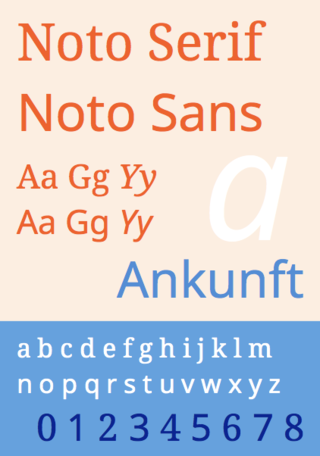UTF-32 (32-bit Unicode Transformation Format) is a fixed-length encoding used to encode Unicode code points that uses exactly 32 bits (four bytes) per code point (but a number of leading bits must be zero as there are far fewer than 232 Unicode code points, needing actually only 21 bits). UTF-32 is a fixed-length encoding, in contrast to all other Unicode transformation formats, which are variable-length encodings. Each 32-bit value in UTF-32 represents one Unicode code point and is exactly equal to that code point's numerical value.

The Unicode Consortium is a 501(c)(3) non-profit organization incorporated and based in Mountain View, California, U.S. Its primary purpose is to maintain and publish the Unicode Standard which was developed with the intention of replacing existing character encoding schemes which are limited in size and scope, and are incompatible with multilingual environments.
An emoji is a pictogram, logogram, ideogram, or smiley embedded in text and used in electronic messages and web pages. The primary function of modern emoji is to fill in emotional cues otherwise missing from typed conversation as well as to replace words as part of a logographic system. Emoji exist in various genres, including facial expressions, expressions, activity, food and drinks, celebrations, flags, objects, symbols, places, types of weather, animals and nature.

The zero-width joiner (‍) is a non-printing character used in the computerized typesetting of writing systems in which the shape or positioning of a grapheme depends on its relation to other graphemes, such as the Arabic script or any Indic script. Sometimes the Roman script is to be counted as complex, e.g. when using a Fraktur typeface. When placed between two characters that would otherwise not be connected, a ZWJ causes them to be printed in their connected forms.

Groucho glasses, also known as nose glasses, the beaglepuss, or the GM 20/20s, are a humorous novelty disguise which function as a caricature of the stage makeup used by the comedian Groucho Marx in his movies and vaudeville performances. They typically consist of black frames with attached features including bushy eyebrows, a large plastic nose, bushy moustache, and sometimes a plastic cigar. Considered one of the most iconic and widely used of all novelty items in the world, Groucho glasses were marketed as early as the 1940s and are instantly recognizable to people throughout the world. The glasses are often used as a shorthand for slapstick and are depicted in the Disguised Face (🥸) emoji.

Pile of Poo (💩), also known informally as the poomoji (slang), poop emoji, or poo emoji, is an emoji resembling a coiled pile of feces, usually adorned with cartoon eyes and a large smile. Originated from Japan, it is used as an expression of various contexts. Some possible uses include: as a response of passive aggressive emotion, for comedic value, as commentary on what's bad, or as its literal meaning.
Apple Color Emoji is a color typeface used on Apple platforms such as iOS and macOS to display Emoji characters.

Noto is a font family comprising over 100 individual computer fonts, which are together designed to cover all the scripts encoded in the Unicode standard. As of October 2016, Noto fonts cover all 93 scripts defined in Unicode version 6.1, although fewer than 30,000 of the nearly 75,000 CJK unified ideographs in version 6.0 are covered. In total, Noto fonts cover over 77,000 characters, which is around half of the 149,186 characters defined in Unicode 15.0.

Jeremy Burge is an Australian emoji historian, founder of Emojipedia, creator of World Emoji Day and widely regarded as an expert on emoji.

Face with Tears of Joy (😂) is an emoji that represents a crying with laughter facial expression. While it is broadly referred to as an emoji, since it is used to demonstrate emotion, it is also referred to as an emoticon. Since the emoji has evolved from numerous different designs pre-unicode, it has different names and meanings in different regions and cultures. It is also known as Tears of Joy emoji, lol emoji, joy emoji, laughing emoji, cry-laugh emoji, crying laughing emoji, or the laughing crying emoji. The emoji is used in communication to portray joking and teasing on messaging platforms including Apple's iMessage and Meta's WhatsApp, as well as social media websites such as Facebook, Snapchat, Twitter, and Instagram. The emoji is one of the most commonly used emojis in the Emoticons Unicode block. The Oxford Dictionary recognized the emoji as its Word of the Year in 2015 due to its popular usage, and regarded it as the most popular emoji.

World Emoji Day is an annual unofficial holiday occurring on 17 July each year, intended to celebrate emoji; in the years since the earliest observance, it has become a popular date to make product or other announcements and releases relating to emoji.

The Eggplant emoji (🍆), also known by its Unicode name of Aubergine, is an emoji featuring a purple eggplant. Social media users have noted the emoji's phallic appearance and often use it as a euphemistic or suggestive icon during sexting conversations, to represent a penis. It is frequently paired and often contrasted with the peach emoji (🍑), representing the buttocks.
Charlie Craggs is a British transgender actress, activist, and author from London.
Shigetaka Kurita is a Japanese interface designer often cited for his early work with emoji sets. Many refer to him as the creator of the emoji, a claim that has been clarified in recent years. He was part of the team that created one of the first emojis used solely for communication, a heart-shaped pictogram that appeared on an NTT DoCoMo pager aimed at teenagers. It went on to become the Red Heart emoji.
Blob emoji is an implementation of emojis by Google featured in its Android mobile operating system between 2013 and 2017.

The mini heart gesture is a trend that was popularized in South Korea in which the index finger and thumb come together like a snap to form a tiny heart. The gesture was popularized by K-pop idols, who would often use the gesture to express their love and gratitude to their fans. It is represented in Unicode with the codepoint U+1FAF0🫰HAND WITH INDEX FINGER AND THUMB CROSSED as "Hand with Index Finger and Thumb Crossed".

iOS 12 is the twelfth major release of the iOS mobile operating system developed by Apple Inc. Aesthetically similar to its predecessor, iOS 11, it focuses more on performance than on new features, quality improvements and security updates. Announced at the company's Worldwide Developers Conference on June 4, 2018, iOS 12 was released to the public on September 17, 2018. It was succeeded for the iPhone and iPod Touch by iOS 13 on September 19, 2019, and for the iPad by iPadOS 13 on September 24, 2019. Security updates for iOS 12 continued for four years after the releases of iOS 13 and iPadOS 13 for devices unable to run the newer versions. The last update, 12.5.7, was released on January 23, 2023.

The Peach emoji (🍑) is a fruit emoji depicting a pinkish-orange peach. The emoji is noted for its resemblance to human buttocks, owing to the center crease, and is consequently frequently used as a euphemism for such on social media. Often paired with the eggplant emoji (🍆), the peach more often represents female.
The implementation of emojis on different platforms took place across a three-decade period, starting in the 1990s. Today, the exact appearance of emoji is not prescribed but can vary between fonts and platforms, much like different typefaces.
The Pistol emoji (🔫) is an emoji usually displayed as a green or orange toy gun or water gun, but historically was displayed as an actual handgun on most older systems. In 2016, Apple replaced its realistic revolver design with a water gun emoji, resulting in other companies similarly changing their renditions over the following years.













